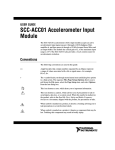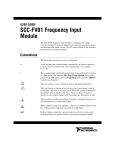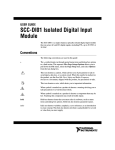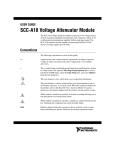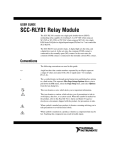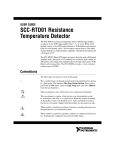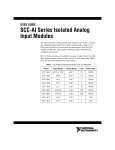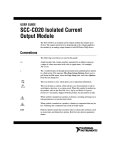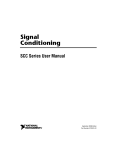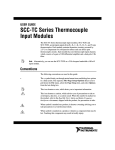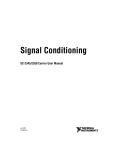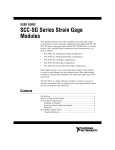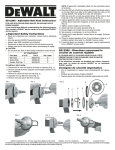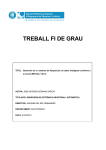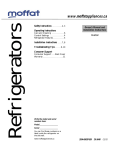Download SCC-DO01 Isolated Digital Output Module User Guide
Transcript
USER GUIDE SCC-DO01 Isolated Digital Output Module The SCC-DO01 is a single-channel, optically isolated digital output module. The output circuitry consists of a photomos relay and a load resistor. You can use the SCC-DO01 with a 5–24 VDC external voltage supply to switch external devices such as transistors and solid-state relays. Conventions The following conventions are used in this guide: » The » symbol leads you through nested menu items and dialog box options to a final action. The sequence File»Page Setup»Options directs you to pull down the File menu, select the Page Setup item, and select Options from the last dialog box. This icon denotes a caution, which advises you of precautions to take to avoid injury, data loss, or a system crash. When this symbol is marked on the product, see the Read Me First: Safety and Radio-Frequency Interference document, shipped with the product, for precautions to take. This icon denotes a note, which alerts you to important information. When symbol is marked on a product, it denotes a warning advising you to take precautions to avoid electrical shock. When symbol is marked on a product, it denotes a component that may be hot. Touching this component may result in bodily injury. bold Bold text denotes items that you must select in software, such as menu items and dialog box options. Bold text also denotes parameter names. italic Italic text denotes variables, emphasis, a cross reference, or an introduction to a key concept. This font also denotes text that is a placeholder for a word or value that you must supply. monospace Text in this font denotes text or characters that you should enter from the keyboard, sections of code, programming examples, and syntax examples. This font is also used for the proper names of disk drives, paths, directories, programs, subprograms, subroutines, device names, functions, operations, variables, filenames, and extensions. SC-2345 SC-2345 refers to both the SC-2345 connector block and the SC-2345 with configurable connectors. SCC SCC refers to any SCC Series signal-conditioning module. What You Need to Get Started To set up and use the SCC-DO01, you need the following items: ❑ SC-2345/2350 with one of the following: – SCC-PWR01 – SCC-PWR02 and the PS01 power supply – SCC-PWR03 (requires a 7 to 42 VDC power supply, not included) ❑ One or more SCC-DO01 modules ❑ SC-2345/2350 User Manual, available at ni.com ❑ SCC-DO01 Isolated Digital Output Module User Guide ❑ SCC Quick Start Guide, available at ni.com ❑ Read Me First: Safety and Radio-Frequency Interference ❑ SC-2345 Quick Reference Label ❑ 68-pin E Series DAQ device, documentation, and 68-pin cable of less than 2 m length ❑ 1/8 in. flathead screwdriver ❑ Numbers 1 and 2 Phillips screwdrivers ❑ Wire insulation strippers ❑ NI-DAQ (current version) for Windows 2000/NT/XP/Me Note The Macintosh operating system is not supported. SCC-DO01 Isolated Digital Output Module User Guide 2 ni.com Device Specific Information For general SCC module installation and signal connection information, and information about the SC-2350 carrier, refer to the SCC Quick Start Guide, available for download at ni.com/manuals. Note Installing the Module Caution Refer to the Read Me First: Safety and Radio-Frequency Interference document before removing equipment covers or connecting/disconnecting any signal wires. Plug the SCC-DO01 into any digital input/output (P0.) socket J(X+9), where X is 0 to 7, on the SC-2345. When you configure the SC-2345 according to the procedure in the SCC Quick Start Guide, the SC-2345 routes the output signal from digital line P0.(X) on the E Series DAQ device. Connecting Loads to the SCC-DO01 The signal names have changed. Refer to ni.com/info and enter rdtntg to confirm the signal names. Note Figure 1 and Figure 2 show two ways to connect a load and an external voltage supply to the SCC-DO01. These configurations have different electrical characteristics, as described in the Specifications section. © National Instruments Corporation 3 SCC-DO01 Isolated Digital Output Module User Guide E Series SCC-DO01 +5 V Status LED 66.5 Ω 1/2 w 16 Ω P0.(X ) D GND 3 Vss + – Power-Up State Switch 2 VOUT 5–24 VDC IO1 Load RLOAD1 1 VCOM 16 Ω = External voltage source may be floating or ground-referenced. Figure 1. Connecting a Load RLOAD1 to VCOM and VOUT (Configuration 1) Figure 1 shows Configuration 1, with a load RLOAD1 connected to the VCOM and VOUT terminals and a voltage supply connected to the VSS and VCOM terminals. Connect Configuration 1 to the SCC-DO01 by completing the following steps: 1. Remove all power from the signal lines. 2. Strip 7 mm (0.27 in.) of insulation from the ends of the signal wires. 3. Insert the wires into the screw terminals. 4. a. Connect the negative lead of the voltage supply and the negative lead from RLOAD1 to screw terminal 1, VCOM. b. Connect the positive lead from RLOAD1 to screw terminal 2, VOUT. c. Connect the positive lead of the voltage supply to screw terminal 1, VSS. Tighten the screws to 0.5 to 0.6 N ⋅ m (4.4 to 5.3 lb ⋅ in.) of torque. SCC-DO01 Isolated Digital Output Module User Guide 4 ni.com E Series SCC-DO01 +5 V Status LED 16 Ω P0.(X ) D GND 66.5 Ω 1/2 w 3 Vss IO2 Load RLOAD2 Power-Up State Switch 2 VOUT + – 5–24 VDC 1 VCOM 16 Ω = External voltage source may be floating or ground-referenced. Figure 2. Connecting a Load RLOAD2 to VOUT and VSS (Configuration 2) Figure 2 shows Configuration 2, with a load RLOAD2 connected to the VOUT and VSS terminals and a voltage supply connected to the VCOM and VSS terminals. Connect Configuration 2 to the SCC-DO01 by completing the following steps: 1. Remove all power from the signal lines. 2. Strip 7 mm (0.27 in.) of insulation from the ends of the signal wires. 3. Insert the wires into the screw terminals. 4. a. Connect the negative lead of the voltage supply to screw terminal 1, VCOM. b. Connect the negative lead from RLOAD2 to screw terminal 2, VOUT. c. Connect the positive lead of the voltage supply and the positive lead from RLOAD2 to screw terminal 1, VSS. Tighten the screws to 0.5 to 0.6 N ⋅ m (4.4 to 5.3 lb ⋅ in.) of torque. For information about configuring the SCC-DO01 module using NI-DAQmx, refer to the SCC Quick Start Guide. © National Instruments Corporation 5 SCC-DO01 Isolated Digital Output Module User Guide Specifications These specifications are typical at 25 °C unless otherwise stated. Output Characteristics Compatibility ..........................................TTL-compatible Number of channels................................1 Supply voltage range ..............................5 to 24 VDC Digital logic levels Configuration 1 (refer to Figure 1) Logic Level Output Voltage Level between VOUT and VCOM Low (IO1 = 0 mA) 0V High (IO1 = 25 mA) 22 VDC at VSS = 24 V 3 VDC at VSS = 5 V Configuration 2 (refer to Figure 2) Logic Level Output Voltage Level between VOUT and VCOM Low (IO2 = 25 mA) 0.4 V High (IO2 = 0 mA) VSS Maximum continuous load current (IO) Configuration 1................................86 mA Configuration 2................................120 mA Minimum load resistance (at VSS = 24 V) RLOAD1 ..............................................196 Ω RLOAD2 ..............................................184 Ω SCC-DO01 Isolated Digital Output Module User Guide 6 ni.com Load Current IO1 (mA) 120 80 40 0 0.1 0.5 0.9 1.3 1.7 Output Voltage Level (V) Load Current IO2 (mA) Figure 3. Load Current versus Output Voltage, Configuration 1 80 40 0 24 22 20 18 16 Output Voltage Level (V) Figure 4. Load Current versus Output Voltage, Configuration 2 Propagation delay Low to high ..................................... 400 µs typ1 High to low ..................................... 300 µs typ1 Rise time ................................................ 120 µs typ Fall time ................................................. 25 µs typ 1 The switching characteristics (turn-on time, switching time, and turn-off time) of the optical isolator used on the board limit the data transfer rate. © National Instruments Corporation 7 SCC-DO01 Isolated Digital Output Module User Guide Power Requirement Digital power ..........................................69 mW max Physical Characteristics Dimensions .............................................8.89 cm × 2.92 cm × 1.85 cm (3.50 in. × 1.15 in. × 0.73 in.) Mass........................................................28.6 g (1.0 oz) I/O connectors.........................................One 20-pin right-angle male connector; one 2-pin screw terminal Field-wiring diameter .............................28 to 16 AWG Maximum Working Voltage Maximum working voltage refers to the signal voltage plus the common-mode voltage. Channel to earth......................................42 V, Installation Category 2 Module to module...................................42 V, Installation Category 2 Environmental Operating temperature ............................0 to 50 °C Storage temperature ................................–20 to 70 °C Humidity .................................................10 to 90% RH, noncondensing Maximum altitude...................................2,000 m Pollution Degree (indoor use only) ........2 Safety The SCC-DO01 meets the requirements of the following standards for safety and electrical equipment for measurement, control, and laboratory use: • IEC 61010-1, EN 61010-15 • UL 3111-1, UL 6101B-1 • CAN/CSA C22.2 No. 1010.1 SCC-DO01 Isolated Digital Output Module User Guide 8 ni.com Note For UL and other safety certifications, refer to the product label, or visit ni.com/hardref.nsf, search by the model number or product line, and click the appropriate link in the Certification column. Electromagnetic Compatibility Emissions ............................................... EN 55011 Class A at 10 m FCC Part 15A above 1 GHz Immunity................................................ EN 61326:1997 + A2:2001, Table 1 CE, C-Tick, and FCC Part 15 (Class A) Compliant Note For full EMC compliance, operate this device with shielded cabling. In addition, all covers and filler panels must be installed. CE Compliance This product meets the essential requirements of applicable European Directives, as amended for CE marking, as follows: Low-Voltage Directive (safety) ............. 73/23/EEC Electromagnetic Compatibility Directive (EMC) .................................... 89/336/EEC Refer to the Declaration of Conformity (DoC) for this product for any additional regulatory compliance information. To obtain the DoC for this product, visit ni.com/hardref.nsf, search by model number or product line, and click the appropriate link in the Certification column. Note © National Instruments Corporation 9 SCC-DO01 Isolated Digital Output Module User Guide Figure 5 shows the I/O connector on the bottom of the SCC-DO01. 4 1 2 3 5 1 Pin 1 2 Pin 2 3 PWB Key 4 Pin 19 5 Pin 20 Figure 5. SCC Module Bottom View Table 1 lists the signal connection corresponding to each pin. GND is the reference for the +5 V supply. Table 1. SCC-DO01 Pin Signal Connections Pin Number Signal 1 — 2 — 3 — 4 — 5 — 6 — 7 P0.(X) 8 — 9 +5 V 10 GND 11 — 12 — 13 — SCC-DO01 Isolated Digital Output Module User Guide 10 ni.com Table 1. SCC-DO01 Pin Signal Connections (Continued) Pin Number Signal 14 — 15 — 16 — 17 — 18 — 19 — 20 — Theory of Operation Setting the Power-Up State of the SCC-DO01 The switch for setting the power-up state of the SCC-DO01 is on the top of the module. Switch it to High or Low depending on whether you want the output state to be high or low on power-up. The switch does not override the output state as determined by the E Series DAQ device. Status LED The SCC-DO01 has a status LED that indicates when an input signal registers a logic high or a logic low. The LED is located above the screw terminals. If the LED is off, the input signal is registering a logic low on the digital line. Circuit Protection Protection Against Spike Voltages Two clamping diodes protect the SCC-DO01 against spike voltages caused by inductive loads and long circuit wires. One diode is connected across VSS and VOUT and the other diode is connected across VOUT and VCOM. © National Instruments Corporation 11 SCC-DO01 Isolated Digital Output Module User Guide Signal Isolation The VCOM, VSS, and VOUT signals on each SCC-DO01 are isolated from other channels and from the SCC-DO01 internal power and ground signals. The isolation barrier protects the SCC-DO01 and other equipment from voltages up to +42 VDC. Common-mode voltages higher than +42 VDC can damage the SCC-DO01 and other equipment. National Instruments™, NI™, ni.com™, and NI-DAQ™ are trademarks of National Instruments Corporation. Product and company names mentioned herein are trademarks or trade names of their respective companies. For patents covering National Instruments products, refer to the appropriate location: Help»Patents in your software, the patents.txt file on your CD, or ni.com/patents. © 2002–2004 National Instruments Corp. All rights reserved. *371077B-01* 371077B-01 Mar04












